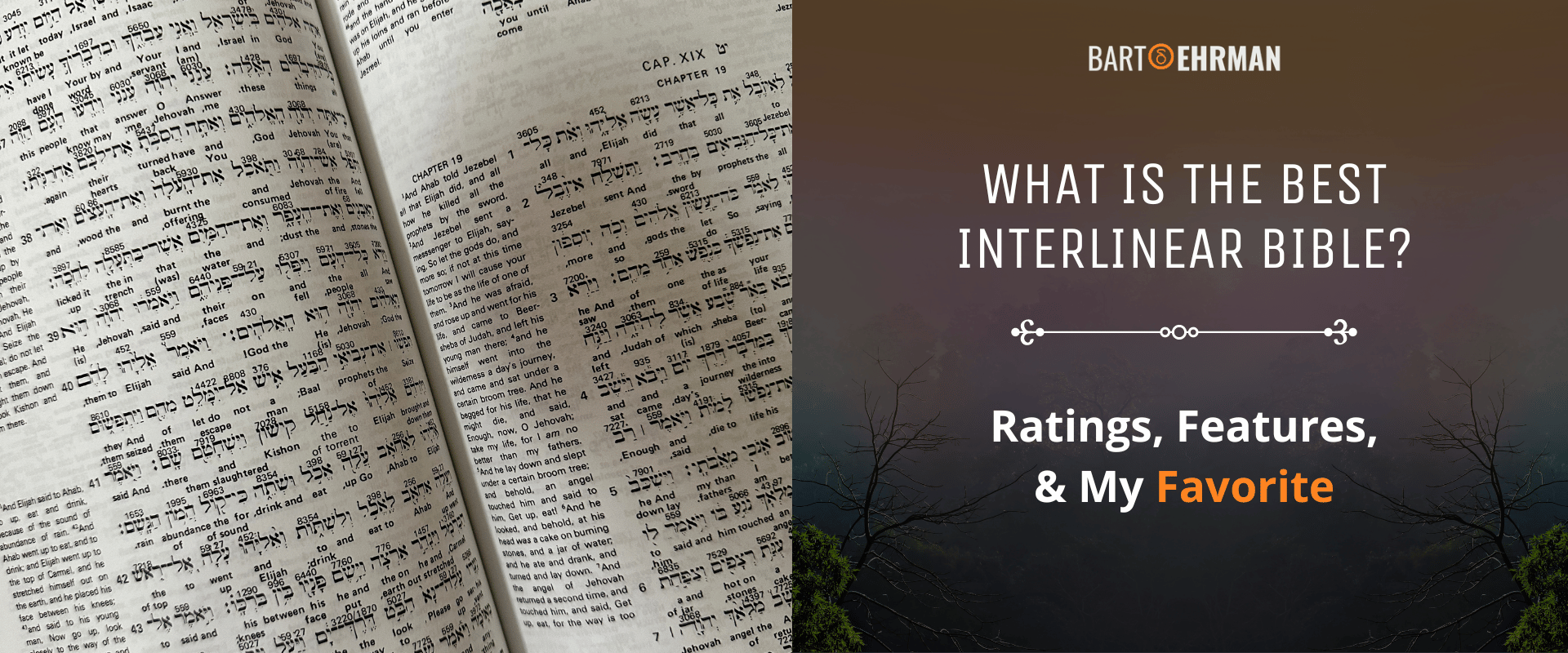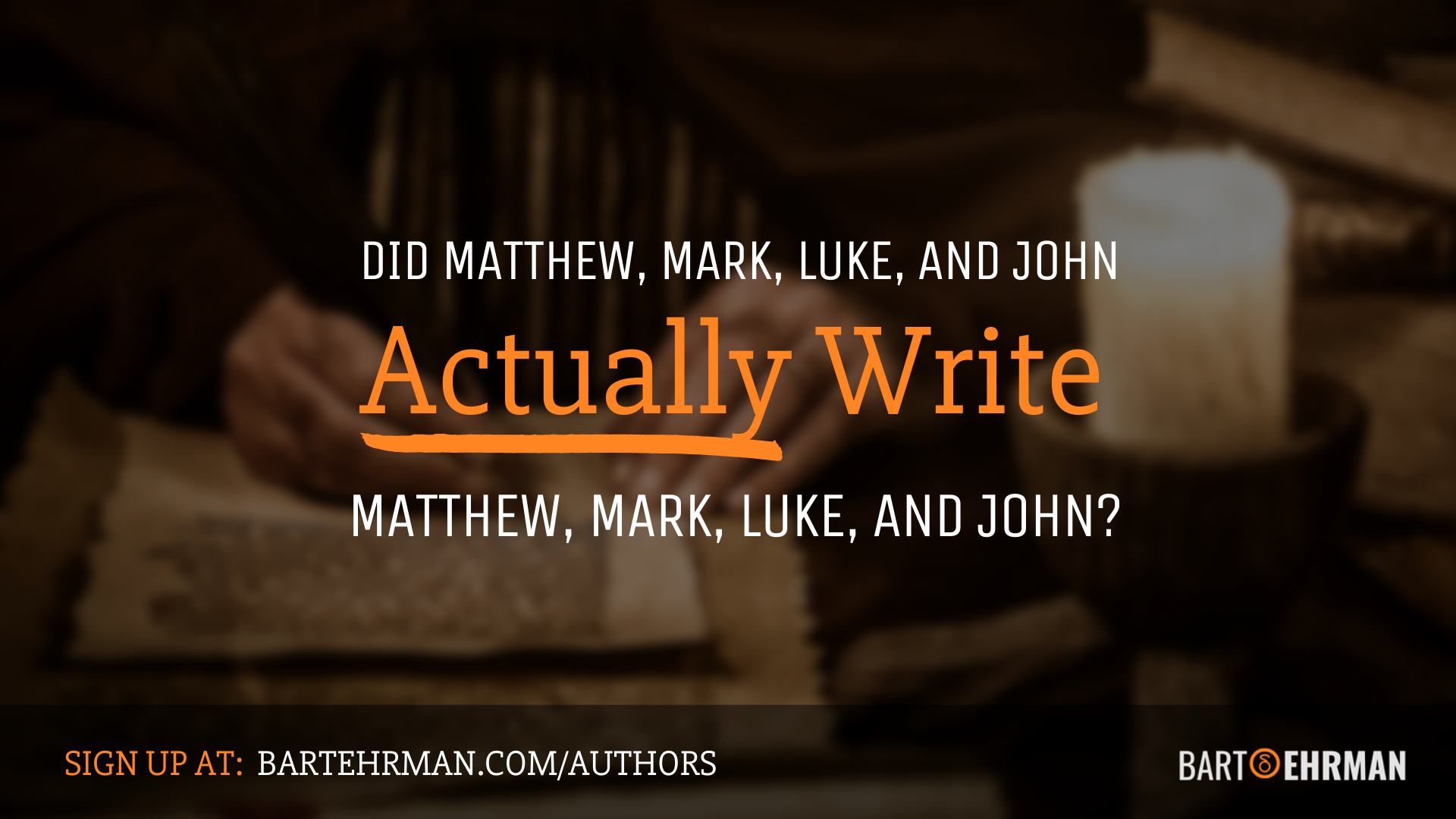What is the Best Interlinear Bible? (Ratings, Features, & My Favorite)

Written by Joshua Schachterle, Ph.D
Author | Professor | Scholar
Author | Professor | BE Contributor
Verified! See our editorial guidelines
Verified! See our guidelines
Date written: June 16th, 2024
Disclaimer: The views and opinions expressed in this article belong to the author and do not necessarily match my own. - Dr. Bart D. Ehrman
Interlinear Bibles bridge the gap between the original Hebrew and Greek texts and modern translations. What is an interlinear Bible? In short, it’s a Bible that displays the biblical texts in their original languages while showing a literal English translation. This gives readers insight into what the original texts actually say.
In this article, I’ll describe the features of an interlinear Bible, recommend the best interlinear Bible for both beginners and scholars, and distinguish interlinear Bibles from parallel Bibles and Gospel harmonies.

What Is an Interlinear Bible?
An interlinear Bible provides the whole text of the Bible in its original languages, with an English translation below. This can be useful for several reasons. For example, it makes it easy to study the meanings and uses of specific biblical words, helping even beginners understand what the original authors intended. In addition, for those learning the biblical languages of Hebrew and Koine Greek, it provides a wonderful tool for understanding their mechanics in context.
Interlinear Bibles are often confused with two other types of Bibles: parallel Bibles and Gospel harmonies. For this reason, I’ll start this section with definitions of each of those types of Bibles before looking at which interlinear Bibles I believe are best.
A parallel Bible is a study Bible in which several different translations of the Bible are printed on the same page, with typically two or three renderings side by side. John 3:16, for example, might look like this:
King James Version (KJV) | New International Version (NIV) | New Revised Standard Version (NRSV) |
|---|---|---|
For God so loved the world, that he gave his only begotten Son, that whosoever believeth in him should not perish, but have everlasting life. | For God so loved the world that he gave his one and only Son, that whoever believes in him shall not perish but have eternal life. | For God so loved the world that he gave his only Son, so that everyone who believes in him may not perish but may have eternal life. |
A parallel Bible shows how different translations might affect the verse’s meaning. For biblical scholars who know the ancient languages in which the Bible was written, this can be an interesting exercise, as many translations are made with theological ends in mind rather than accurate language. If you don’t know those original languages, it can still be interesting to see how the text has been interpreted differently.
A Gospel harmony, on the other hand, is an attempt to take the narratives of all four canonical Gospels and weave them into one story. In other words, it assumes there are no contradictions between Gospel accounts — that they’re all telling the same story, with different emphases. Some harmonies are written in narrative form, while others are charts showing events shared across Gospels like this:
Event | Matthew | Mark | Luke | John |
|---|---|---|---|---|
Crown of Thorns | Matthew 27:29 | Mark 15:17 | John 19:2-5 | |
Blood Curse | Matthew 27:24-25 | |||
Carrying the Cross | Matthew 27:27-33 | Mark 15:20-22 | Luke 23:26-32 | John 19:16-17 |
Crucifixion of Jesus | Matthew 27:34-61 | Mark 15:23-47 | Luke 23:33-54 | John 19:18-38 |
However, as Bart Ehrman writes, the Gospels contradict each other many times. Yet the desire to harmonize all the Gospel accounts goes back to ancient times. In the 2nd century CE, for example, an Assyrian Christian named Tatian wrote the first Gospel harmony called the Diatessaron, Greek for “out of four.” Since then, Christians have made multiple versions throughout history.
An interlinear Bible, on the other hand, is a whole different animal. It attempts to take the original languages of the Bible – Hebrew for the Hebrew Bible and Greek for the New Testament – and show how they translate word-for-word into the target language. It might look like this:

Source: https://www.abarim-publications.com/Bible_Commentary/Monogenes.html
Interlinear Bibles allow people not familiar with the Bible’s original languages to see what they literally say. For biblical scholars, this may not be so helpful. Those who already know the original languages often prefer to translate them on their own.
However, if I were studying modern Christianity, an interlinear Bible might help me get at why specific translations used by certain denominations chose to interpret a biblical passage in particular ways.
Having defined interlinear Bibles, I’ll next look at which interlinear Bibles I think are best.
The Best Interlinear Bible for Beginners
(Affiliate Disclaimer: We may earn commissions on products you purchase through this page at no additional cost to you. Thank you for supporting our site!)
Ratings: 4 ½ out of 5 stars on Amazon
Overview:
A full interlinear Bible is a massive undertaking, which is why this comes in the following four volumes:
- Volume 1 (Hebrew-English): Genesis-Ruth
- Volume 2 (Hebrew-English): 1 Samuel-Psalm 55
- Volume 3 (Hebrew-English): Psalm 56-Malachi
- Volume 4 (Greek-English): New Testament
Features:
This version is easy to read and has ample commentary to help beginners understand the language and cultural issues featured in the texts. It uses the Masoretic Text — the official Hebrew and Aramaic text of the 24 books of the Hebrew Bible in Rabbinic Judaism — for the Old Testament texts, which is good. However, it uses the Textus Receptus — a set of biblical texts which were translated back into Greek from Latin in the 16th century — for the New Testament. This isn’t great source material for the New Testament. However, for a beginner, this shouldn’t really be a problem (for scholars, the source material is more important).
Pros and Cons:
This is a very comprehensive version containing a lot of information. For a beginner, in fact, it’s far more than you’ll be able to take in! In addition, it includes a concordance. This alphabetical list of words from the Bible points you to all the instances of each one in the text. This can be very helpful when you want to find multiple passages talking about a certain topic.
Besides the fact that it uses the Textus Receptus as source material for the New Testament, the only other possible downside to this version is that it was made by an Evangelical Christian, and his beliefs may have affected his translation. If you are trying to approach the Bible in a scholarly way, potential bias is something to look out for.
Amazon customer review - "This Bible is user-friendly. The layout of this Bible is easy to read and follow in the Hebrew & Greek. The numbers are well displayed to trace to the Strong's Exhaustive Concordance... I can now finally satisfy my curiosity about complete and accurate word meanings. Having access to the whole Interlinear Bible makes cross referencing much faster..."
The Best Interlinear Bible for Scholars
OT Ratings: 5 out of 5 stars on Amazon
NT Ratings: 4 ½ out of 5 stars on Amazon
Overview:
As I said before, for scholars, the source material from which any Bible translation comes is paramount. These two volumes, one for the Old Testament and another for the New Testament, are made by the same company. Their source material is the standard Masoretic Text for the Old Testament, and the Nestle-Aland for the New Testament. The Nestle-Aland is the Greek text of the New Testament compiled by an academic committee who compared readings from many manuscripts to determine which reading is most likely the original.
Features:
In addition to the interlinear, the OT volume has a spread in which one page shows just the English rendering of a passage, while the other shows only the Hebrew. For the NT volume, each page has the Greek text laid out word-by-word above an English glossary indicating each word's basic meaning and morphology.
Pros and Cons:
Both are easy to read and use good source material.
The downside is that the basic translation is the English Standard Version rather than the New Revised Standard Version (NRSV) most scholars use. However, they typically know enough of the biblical languages to sniff out inaccuracies in the translation.
Amazon customer review - “If you can afford only one Hebrew-English Interlinear text, I heartily recommend this one.”
Amazon customer review - “As a Greek student with the knowledge gained from a year of beginning Greek (Mounce), I have found this Greek-English New Testament very helpful in taking my Greek further along.”

The Most Accurate Interlinear Bible
OT Ratings: 4 out of 5 stars on Amazon
NT Ratings: 4 ½ out of 5 stars on Amazon
Overview:
Again, the most accurate versions I could find were in versions sold by separate companies. The OT version is from Livingson Press, while the well-known Christian publisher Zondervan publishes the NT version.
Features:
OT – It is based on the Masoretic text and contains a companion dictionary, which is useful for explaining key Hebrew terms that may not have modern English equivalences
NT – This version contains an interlinear Bible and a parallel Bible. It is based on the Nestle-Aland and contains helpful textual notes for understanding Greek vocabulary and concepts.
Pros and Cons:
OT – This version is based correctly on the Masoretic Text and contains notes that might help a beginner not familiar with Hebrew idioms and grammar. However, it does not use the NRSV translation — the most accurate English translation according to most scholars. I was unhappy to find that there are no interlinear OTs that use the NRSV.
NT – This also uses the correct source material, the Nestle-Aland, and contains a lot of good information on Greek language and ideas. It has the further benefit of including the NRSV translation. Conversely, it also contains the New International Version (NIV), which has many accuracy problems.
OT Amazon customer review - “The book is very helpful to learn Biblical Hebrew. I’m gonna order the other two volumes soon. Thank you.”
NT Amazon customer review - “This Interlinear translation absolutely ROCKS! Just when you think you have the information you need, Alfred Marshall trumps everybody one more time!”
My Favorite Interlinear Bible(s)
OT Ratings: 5 out of 5 stars on Amazon
NT Ratings: 4 ½ out of 5 stars on Amazon
Overview:
Yes, this is the same one I recommended for scholars (I am a scholar, after all!). They both use the correct source material, which helps the translation. Also, because I know the biblical languages, I can assess for myself the accuracy of the translations.
Features:
Both are easy to read and have helpful information on the sides of each page.
Pros and Cons:
Again, I like that I can trust the source material and I appreciate the helpful comments. As I said above, though, I don’t love the ESV. It’s not the worst Bible translation, but it’s certainly not the best.
Amazon customer review - “If you can afford only one Hebrew-English Interlinear text, I heartily recommend this one.”
Amazon customer review - “As a Greek student with the knowledge gained from a year of beginning Greek (Mounce), I have found this Greek-English New Testament very helpful in taking my Greek further along.”
Conclusion
Interlinear Bibles can be helpful tools. Those learning the biblical languages can augment their learning with them, while total novices can see what the original text said (provided the Bible uses the correct textual sources).
I hope the above recommendations are helpful, offering one more tool for understanding the insights of biblical scholarship.
FREE COURSE!
WHY I AM NOT A CHRISTIAN
Raw, honest, and enlightening. Bart's story of why he deconverted from the Christian faith.
Over 6,000 enrolled!

